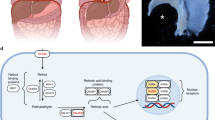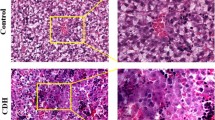Abstract
Background and purpose: Human studies note sex reversal syndromes and sex difference(s) in the incidence of congenital diaphragmatic hernia (CDH). Epidemiology surveys record a higher incidence of CDH in females, whilst other reports cite a higher frequency in males. Nitrofen, a teratogen, produces experimental CDH. This agent is speculated to interfere with retinoid acid–steroid signalling pathways and may also be linked with sexual differentiation. This study was designed therefore to test the hypothesis that nitrofen may influence sexual phenotype and frequency of CDH. Methods: Time mated Sprague Dawley rats were dosed with nitrofen at day 9.5 to generate predominantly left sided CDH. Fetuses were delivered by caesarean section on days 20 or 21 of gestation (term=day 22). External genitalia were examined to define external genital phenotype. The abdominal cavity was opened and the genito-urinary system carefully examined. The internal genital organs were assigned a phenotype and findings correlated with external appearances. The diaphragm of each fetus was studied for the absence or presence of CDH and the laterality of defect recorded. Controls (non nitrofen fed) were used for all comparative analysis. Results: Control (n=600) and nitrofen exposed offspring (n=504) had equal frequencies of males and females. CDH occurred with similar incidence in male and female nitrofen treated pups. In all nitrofen exposed fetuses and normal controls, internal and external genitalia concorded without evidence of significant genital tract malformations or intersex states. Conclusions: Prenatal nitrofen exposure is not associated with significant gender differences (or prenatal loss) in the risk of CDH. Genital tract malformations do not appear to accompany CDH in the nitrofen model.





Similar content being viewed by others
References
Ambrose AM, Larson PS, Borzelleca JF, Smith RB Jr, Hennigar GR Jr (1971) Toxicologic studies on 2,4-dichlorophenyl-p-nitrophenyl ether. Toxicol Appl Pharmacol 19:263–275
Kluth D, Kangah R, Reich P, Tenbrinck R, Tibboel D, Lambrecht W (1990) Nitrofen-induced diaphragmatic hernias in rats: an animal model. J Pediatr Surg 25:850–854
Babiuk RP, Thebaud B, Greer JJ (2004) Reductions in the incidence of nitrofen-induced diaphragmatic hernia by vitamin A and retinoic acid. Am J Physiol Lung Cell Mol Physiol 286:L970–L973
Chen MH, MacGowan A, Ward S, Bavik C, Greer JJ (2003) The activation of the retinoic acid response element is inhibited in an animal model of congenital diaphragmatic hernia. Biol Neonate 83:157–161
Greer JJ, Babiuk RP, Thebaud B (2003) Etiology of congenital diaphragmatic hernia: the retinoid hypothesis. Pediatr Res 53:726–730
Mey J, Babiuk RP, Clugston R, Zhang W, Greer JJ (2003) Retinal dehydrogenase-2 is inhibited by compounds that induce congenital diaphragmatic hernias in rodents. Am J Pathol 162:673–679
Killeen OG, Kelehan P, Reardon W (2002) Double vagina with sex reversal, congenital diaphragmatic hernia, pulmonary and cardiac malformations—another case of meacham syndrome. Clin Dysmorphol 11:25–28
Kent A, Simpson E, Ellwood D, Silink M (2004) 46 XY sex-reversal (Swyer syndrome) and congenital diaphragmatic hernia. Am J Med Genet 15:131:103–105
Butler N, Claireaux AE (1962) Congenital diaphragmatic hernia as a cause of perinatal mortality. Lancet 1:659–663
David TJ, Illingworth CA (1976) Diaphragmatic hernia in the South-West of England. J Med Genet 13:253–262
Robert E, Kallen B, Harris J (1997) The epidemiology of diaphragmatic hernia. Eur J Epidemiol 13:665–673
Yang P, Khoury MJ, Stewart WF, Beaty TH, Chee E, Beatty JC, Diamond EL, Gordis L (1994) Comparative epidemiology of selected midline congenital abnormalities. Genet Epidemiol 11:141–154
Sweed Y, Puri P (1993) Congenital diaphragmatic hernia: influence of associated malformations on survival. Arch Dis Child 69:68–70
Fauza DO, Wilson JM (1994) Congenital diaphragmatic hernia and associated anomalies: their incidence, identification, and impact on prognosis. J Pediatr Surg 29:1113–1117
Losty PD, Vanamo K, Rintala RJ, Donahoe PK, Okoye, Schnitzer JJ, Lloyd DA (1998) Congenital diaphragmatic hernia—Does the side of the defect influence the incidence of associated malformations? J Pediatr Surg 33:1–5
Harrison MR, Bjordal RI, Langmark F, Knutrud O (1978) Congenital diaphragmatic hernia: the hidden mortality. J Pediatr Surg 13:227–230
Author information
Authors and Affiliations
Corresponding author
Rights and permissions
About this article
Cite this article
Connell, M., Corbett, H., Purvis, A. et al. Sex and congenital diaphragmatic hernia. Ped Surgery Int 22, 95–98 (2006). https://doi.org/10.1007/s00383-005-1579-2
Published:
Issue Date:
DOI: https://doi.org/10.1007/s00383-005-1579-2




